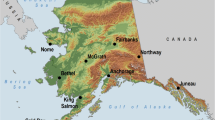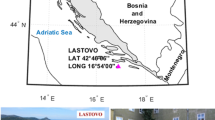Abstract
Extreme temperature events and their long-term variability are investigated using daily air temperature data from Murmansk weather station for the period of 1942–2018. It was found that the variability of extremely warm and cold events in Murmansk in winter is mainly explained rather by the dynamics of storm tracks than by the local processes of air mass transformation in the region. It is shown that the main characteristics of extreme events demonstrate a clearly pronounced seasonality. It was revealed that the positive trend in seasonal mean temperatures is mainly due to the reduced number of extremely cold events in Murmansk. The study shows that the leading factor determining the variability of extreme events is the Arctic Oscillation (AO). In turn, the AO anomalies are formed as a result of the dynamic stratosphere–troposphere coupling, which is expressed in the response of storm tracks to sudden stratospheric warmings.





Similar content being viewed by others
REFERENCES
D. D. Bokuchava and V. A. Semenov, “Analysis of Surface Air Temperature Anomalies in the Northern Hemisphere in the 20th Century Using Observational and Reanalysis Data,” Fundamental’naya i Prikladnaya Klimatologiya, No. 1 (2018) [in Russian].
A. M. Kotilevskaya, “Weather on the Territory of the Russian Federation in July 2010,” Meteorol. Gidrol., No. 10 (2010) [in Russian].
V. N. Kryzhov, “Causes of November Cooling of the 1980s–1990s in European Russia,” Meteorol. Gidrol., No. 1 (2008) [Russ. Meteorol. Hydrol., No. 1, 33 (2008)].
V. N. Kryzhov and O. V. Gorelits, “The Arctic Oscillation and Its Impact on Temperature and Precipitation in Northern Eurasia in the 20th Century,” Meteorol. Gidrol., No. 11 (2015) [Russ. Meteorol. Hydrol., No. 11, 40 (2015)].
L. N. Parshina, “Weather on the Territory of the Russian Federation in August 2010,” Meteorol. Gidrol., No. 11 (2010) [in Russian].
Kh. Kh. Rafailova, Using Stratospheric, Tropospheric, and Earth Surface Characteristics in Long-range Weather Forecasting (Gidrometeoizdat, Leningrad, 1973) [in Russian].
Kh. Kh. Rafailova, “Taking into Account Lower Stratospheric Circulation Features in Monthly Weather Forecasting,” Meteorol. Gidrol., No. 6 (1968) [in Russian].
N. E. Chubarova, E. I. Nezval’, I. B. Belikov, E. V. Gorbarenko, I. D. Eremina, E. Yu. Zhdanova, I. A. Korneva, P. I. Konstantinov, M. A. Lokoshchenko, A. I. Skorokhod, and O. A. Shilovtseva, “Climatic and Environmental Characteristics of Moscow Megalopolis According to the Data of the Moscow State University Meteorological Observatory over 60 Years,” Meteorol. Gidrol., No. 9 (2014) [Russ. Meteorol. Hydrol., No. 9, 39 (2014)].
N. P. Shakina and A. R. Ivanova, “The Blocking Anticyclones: The State of Studies and Forecasting,” Meteorol. Gidrol., No. 11 (2010) [Russ. Meteorol. Hydrol., No. 11, 35 (2010)].
M. Akperov, V. A. Semenov, I. I. Mokhov, W. Dorn, and A. Rinke, “Impact of Atlantic Water Inflow on Winter Cyclone Activity in the Barents Sea: Insights from Coupled Regional Climate Model Simulations,” Environ. Res. Lett., No. 2, 15 (2020).
M. P. Baldwin and T. J. Dunkerton, “Stratospheric Harbingers of Anomalous Weather Regimes,” Science, No. 5542, 294 (2001).
J. Ballester, H. Douville, and F. Chauvin, “Present-day Climatology and Projected Changes of Warm and Cold Days in the CNRM-CM3 Global Climate Model,” Clim. Dyn., No. 1, 32 (2009).
A. G. Barnston and R. E. Livezey, “Classification, Seasonality and Persistence of Low-frequency Atmospheric Circulation Patterns,” Mon. Wea. Rev., No. 6, 115 (1987).
R. Bekryaev, I. Polyakov, and V. Alexeev, “Role of Polar Amplification in Long-term Surface Air Temperature Variations and Modern Arctic Warming,” J. Climate, 23 (2010).
L. Bengtsson, V. A. Semenov, and O. M. Johannessen, “The Early Twentieth-century Warming in the Arctic—A Possible Mechanism,” J. Climate, No. 20, 17 (2004).
N. L. Bindoff, P. Stott, K. Achutarao, M. R. Allen, N. Gillett, D. Gutzler, K. Hansingo, G. Hegerl, Y. Hu, S. Jain, R. Sebbari, and X. Zhang, “Detection and Attribution of Climate Change: From Global to Regional,” in Climate Change 2013: The Physical Science Basis. Contribution of Working Group I to the Fifth Assessment Report of the Intergovernmental Panel on Climate Change (Cambridge Univ. Press, 2013).
A. Borodina, E. M. Fischer, and R. Knutti, “Potential to Constrain Projections of Hot Temperature Extremes,” J. Climate, No. 24, 30 (2017).
A. H. Butler, J. P. Sjoberg, D. J. Seidel, and K. H. Rosenlof, “A Sudden Stratospheric Warming Compendium,” Earth Syst. Sci. Data, 9 (2017).
A. J. Charlton and L. M. Polvani, “A New Look at Stratospheric Sudden Warmings. Part I: Climatology and Modeling Benchmarks,” J. Climate, No. 3, 20 (2007).
J. H. Christensen, B. Hewitson, and A. Busuioc, “Regional Climate Projections,” in Climate Change 2007: The Physical Science Basis. Contribution of Working Group I to the Fourth Assessment Report of the Intergovernmental Panel on Climate Change (Cambridge Univ. Press, 2007).
H. de Vries, R. J. Haarsma, and W. Hazeleger, “Western European Cold Spells in Current and Future Climate,” Geophys. Res. Lett., No. 4, 39 (2012).
M. G. Donat, A. L. Lowry, L. V. Alexander, P. A. O’Gorman, and N. Maher, “More Extreme Precipitation in the World’s Dry and Wet Regions,” Nat. Clim. Chang., No. 5, 6 (2016).
A. Dosio and E. M. Fischer, “Will Half a Degree Make a Difference? Robust Projections of Indices of Mean and Extreme Climate in Europe under 1.5°C, 2°C, and 3°C Global Warming,” Geophys. Res. Lett., No. 2, 45 (2018).
J. G. Dwyer and P. A. O’Gorman, “Changing Duration and Spatial Extent of Midlatitude Precipitation Extremes Across Different Climates,” Geophys. Res. Lett., No. 11, 44 (2017).
C. B. Field, V. Barros, T. F. Stocker, and Q. Dahe, Managing the Risks of Extreme Events and Disasters to Advance Climate Change Adaptation: Special Report of the Intergovernmental Panel on Climate Change (Cambridge Univ. Press, 2012).
C. K. Folland, J. Knight, H. W. Linderholm, D. Fereday, S. Ineson, and J. W. Hurrell, “The Summer North Atlantic Oscillation: Past, Present, and Future,” J. Climate, No. 5, 22 (2009).
S. K. Gulev and K. Belyaev, “Probability Distribution Characteristics for Surface Air Sea Turbulent Heat Fluxes over the Global Ocean,” J. Climate, No. 1, 25 (2012).
M. Honda, J. Inoue, and S. Yamane, “Influence of Low Arctic Sea-ice Minima on Anomalously Cold Eurasian Winters,” Geophys. Res. Lett., No. 8, 36 (2009).
J. Kidston, A. Scaife, S. Hardiman, D. Mitchell, N. Butchart, M. Baldwin, and L. Gray, “Stratospheric Influence on Tropospheric Jet Streams, Storm Tracks and Surface Weather,” Nat. Geosci., No. 6, 8 (2015).
S. Kobayashi, Y. Ota, Y. Harada, A. Ebita, M. Moriya, H. Onoda, K. Onogi, H. Kamahori, C. Kobayashi, H. Endo, K. Miyaoka, and K. Takahashi, “The JRA-55 Reanalysis: General Specifications and Basic Characteristics,” J. Meteorol. Soc. Japan. Ser. II, No. 1, 93 (2015).
J. Nie, P. Wang, W. Yang, and B. Tan, “Northern Hemisphere Storm Tracks in Strong AO Anomaly Winters,” Atmos. Sci. Lett., No. 3, 9 (2008).
NOAA National Centers for Environmental information, Climate at a Glance: Global Time Series, https://www.ncdc.noaa.gov/cag/ (Published September 2020, Retrieved on October 2, 2020).
J. Overland and M. Wang, “Large-scale Atmospheric Circulation Changes Associated with the Recent Loss of Arctic Sea Ice,” Tellus A, 62 (2010).
V. Petoukhov and V. A. Semenov, “A Link between Reduced Barents-Kara Sea Ice and Cold Winter Extremes over Northern Continents,” J. Geophys. Res. Atmos., No. D21, 115 (2010).
S. Pfahl, P. A. O’Gorman, and E. M. Fischer, “Understanding the Regional Pattern of Projected Future Changes in Extreme Precipitation,” Nat. Clim. Change, No. 6, 7 (2017).
D. F. Porter, J. J. Cassano, and M. C. Serreze, “Local and Large-scale Atmospheric Responses to Reduced Arctic Sea Ice and Ocean Warming in the WRF Model,” J. Geophys. Res. Atmos., No. D11, 117 (2012).
E. Post, B. A. Steinman, and M. E. Mann, “Acceleration of Phenological Advance and Warming with Latitude over the Past Century,” Sci. Rep., No. 1, 8 (2018).
V. N. Razuvaev, E. G. Apasova, R. A. Martuganov, R. S. Vose, and P. M. Steurer, Daily Temperature and Precipitation Data for 223 USSR Stations, No. ORNL/CDIAC-56; NDP-040 (Oak Ridge National Lab., 1993).
J. Screen, I. Simmonds, C. Deser, and R. Tomas, “The Atmospheric Response to Three Decades of Observed Arctic Sea Ice Loss,” J. Climate, 26 (2013).
V. A. Semenov, M. Latif, D. Dommenget, N. S. Keenlyside, A. Strehz, T. Martin, and W. Park, “The Impact of North Atlantic–Arctic Multidecadal Variability on Northern Hemisphere Surface Air Temperature,” J. Climate, No. 21, 23 (2010).
M. C. Serreze, A. P. Barrett, J. C. Stroeve, D. N. Kindig, and M. M. Holland, “The Emergence of Surface-based Arctic Amplification,” Cryosphere, No. 1, 3 (2009).
P. M. Sousa, R. M. Trigo, D. Barriopedro, P. M. M. Soares, and J. A. Santos, “European Temperature Responses to Blocking and Ridge Regional Patterns,” Clim. Dyn., No. 1–2, 50 (2018).
D. W. J. Thompson and J. M. Wallace, “Annular Modes in the Extratropical Circulation. Part I: Month to Month Variability,” J. Climate, 13 (2000).
D. W. J. Thompson and J. M. Wallace, “The Arctic Oscillation Signature in Wintertime Geopotential Height and Temperature Fields,” Geophys. Res. Lett., 25 (1998).
D. W. J. Thompson, J. M. Wallace, and G. C. Hegerl, “Annular Modes in the Extratropical Circulation. Part II: Trends,” J. Climate, No. 5, 13 (2000).
T. Vihma, “Effects of Arctic Sea Ice Decline on Weather and Climate: A Review,” Surv. Geophys., No. 5, 35 (2014).
D. S. Wilks, Statistical Methods in the Atmospheric Sciences: An Introduction (Elsevier Science, 1995).
X.-H. Yan, T. Boyer, K. Trenberth, T. R. Karl, S.-P. Xie, V. Nieves, K.-K. Tung, and D. Roemmich, “The Global Warming Hiatus: Slowdown or Redistribution?”, Earth’s Future, 4 (2016).
X.-Y. Yang and X. Yuan, “The Early Winter Sea Ice Variability under the Recent Arctic Climate Shift,” J. Climate, No. 13, 27 (2014).
X.-Y. Yang, X. Yuan, and M. Ting, “Dynamical Link between the Barents–Kara Sea Ice and the Arctic Oscillation,” J. Climate, No. 14, 29 (2016).
X. Zhang, G. Hegerl, F. Zwiers, and J. Kenyon, “Avoiding Inhomogeneity in Percentile-based Indices of Temperature Extremes,” J. Climate, 18 (2005).
X. Zhou and M. F. Khairoutdinov, “Changes in Temperature and Precipitation Extremes in Superparameterized CAM in Response to Warmer SSTs,” J. Climate, No. 24, 30 (2017).
Y. A. Zyulyaeva, J. H. P. Studholme, and I. I. Zveryaev, “Long-term Changes in Wintertime Temperature Extremes in Moscow and Their Relation to Regional Atmospheric Dynamics,” J. Geophys. Res. Atmos., No. 1, 124 (2019).
Y. A. Zyulyaeva, I. I. Zveryaev, and K. P. Koltermann, “Observations-based Analysis of the Summer Temperature Extremes in Moscow,” Int. J. Climatol., No. 2, 36 (2016).
Author information
Authors and Affiliations
Corresponding author
Additional information
Translated from Meteorologiya i Gidrologiya, 2022, No. 2, pp. 106-118. https://doi.org/10.52002/0130-2906-2022-2-106-118.
About this article
Cite this article
Selivanova, Y.V., Zyulyaeva, Y.A. & Zveryaev, I.I. Temperature Variability in Murmansk over the Last 70 Years: Long-term Trends and Extreme Events. Russ. Meteorol. Hydrol. 47, 148–157 (2022). https://doi.org/10.3103/S1068373922020091
Received:
Revised:
Accepted:
Published:
Issue Date:
DOI: https://doi.org/10.3103/S1068373922020091




